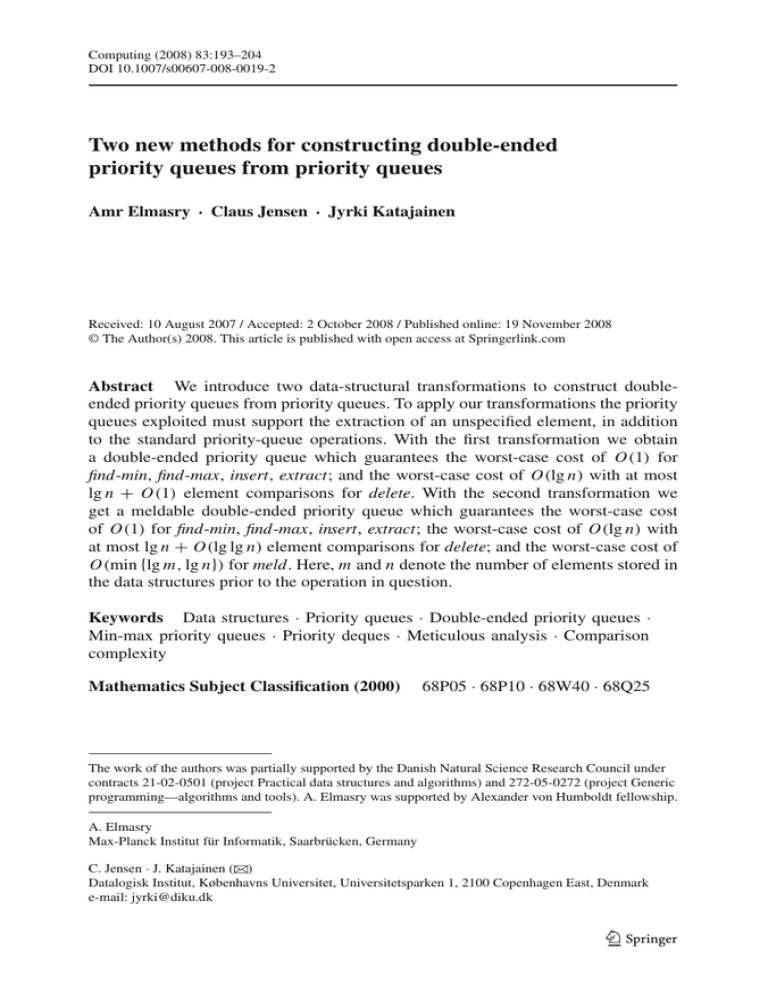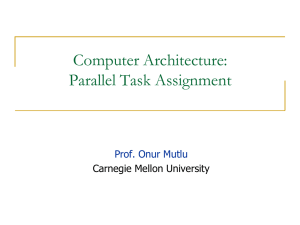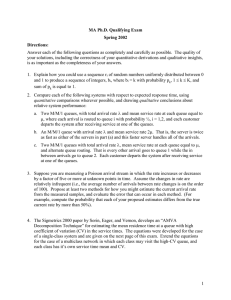Two new methods for constructing double
advertisement

Computing (2008) 83:193–204
DOI 10.1007/s00607-008-0019-2
Two new methods for constructing double-ended
priority queues from priority queues
Amr Elmasry · Claus Jensen · Jyrki Katajainen
Received: 10 August 2007 / Accepted: 2 October 2008 / Published online: 19 November 2008
© The Author(s) 2008. This article is published with open access at Springerlink.com
Abstract We introduce two data-structural transformations to construct doubleended priority queues from priority queues. To apply our transformations the priority
queues exploited must support the extraction of an unspecified element, in addition
to the standard priority-queue operations. With the first transformation we obtain
a double-ended priority queue which guarantees the worst-case cost of O(1) for
find-min, find-max, insert, extract; and the worst-case cost of O(lg n) with at most
lg n + O(1) element comparisons for delete. With the second transformation we
get a meldable double-ended priority queue which guarantees the worst-case cost
of O(1) for find-min, find-max, insert, extract; the worst-case cost of O(lg n) with
at most lg n + O(lg lg n) element comparisons for delete; and the worst-case cost of
O(min {lg m, lg n}) for meld. Here, m and n denote the number of elements stored in
the data structures prior to the operation in question.
Keywords Data structures · Priority queues · Double-ended priority queues ·
Min-max priority queues · Priority deques · Meticulous analysis · Comparison
complexity
Mathematics Subject Classification (2000)
68P05 · 68P10 · 68W40 · 68Q25
The work of the authors was partially supported by the Danish Natural Science Research Council under
contracts 21-02-0501 (project Practical data structures and algorithms) and 272-05-0272 (project Generic
programming—algorithms and tools). A. Elmasry was supported by Alexander von Humboldt fellowship.
A. Elmasry
Max-Planck Institut für Informatik, Saarbrücken, Germany
C. Jensen · J. Katajainen (B)
Datalogisk Institut, Københavns Universitet, Universitetsparken 1, 2100 Copenhagen East, Denmark
e-mail: jyrki@diku.dk
123
194
A. Elmasry et al.
1 Introduction
In this paper, we study efficient realizations of data structures that can be used to
maintain a collection of double-ended priority queues. The fundamental operations to
be supported include find-min, find-max, insert, and delete. For single-ended priority
queues only find-min or find-max is supported. A (double-ended) priority queue is
called meldable if it also supports operation meld. Even though the data-structural
transformations to be presented are fully general, our main focus is on the comparison complexity of double-ended priority-queue operations. Throughout this paper
we use m and n to denote the number of elements stored in a data structure prior to
an operation and lg n as a shorthand for log2 (max {2, n}). Many data structures [2,3,5,
7–11,17–21,23–25] have been proposed for the realization of a double-ended priority
queue, but none of them achieve lg n + o(lg n) element comparisons per delete, if findmin, find-max, and insert must have the worst-case cost of O(1).
We use the word RAM as our model of computation as defined in [15]. We assume
the availability of instructions found in contemporary computers, including built-in
functions for allocating and freeing memory. We use the term cost to denote the sum
of instructions, element constructions, element destructions, and element comparisons
performed.
When defining a (double-ended) priority queue, we use the locator abstraction
discussed in [14]. A locator is a mechanism for maintaining the association between
an element and its current position in a data structure. A locator follows its element
even if the element changes its position inside the data structure.
Our goal is to develop realizations of a double-ended priority queue that support
the following operations:
find-min(Q) (find-max(Q)). Return a locator to an element that, of all elements in
double-ended priority queue Q, has a minimum (maximum) value. If Q is empty,
return a null locator.
insert(Q, p). Add an element with locator p to double-ended priority queue Q.
extract(Q). Extract an unspecified element from double-ended priority queue Q and
return a locator to that element. If Q is empty, return a null locator.
delete(Q, p). Remove the element with locator p from double-ended priority queue
Q (without destroying the element).
Of these operations, extract is non-standard, but we are confident that it is useful,
for example, for data-structural transformations. The following operations may also
be provided.
meld(Q, R). Move all elements from double-ended priority queues Q and R to
a new double-ended priority queue S, destroy Q and R, and return S.
decrease(Q, p, x) (increase(Q, p, x)). Replace the element with locator p by
element x, which should not be greater (smaller) than the old element.
123
Constructing double-ended priority queues from priority queues
195
Any double-ended priority queue can be used for sorting (say, a set of size n).
So if find-min (find-max) and insert have a cost of O(1), delete must perform at
least lg n − O(1) element comparisons in the worst case in the decision-tree model.
Similarly, as observed in [21], if find-min (find-max) and insert have a cost of O(1),
increase (decrease) must perform at least lg n − O(1) element comparisons in the
worst case. Recall, however, that single-ended priority queues can support find-min,
insert, and decrease (or find-max, insert, and increase) at the worst-case cost
of O(1) (see, for example, [6]).
1.1 Previous approaches
Most realizations of a (meldable) double-ended priority queue—but not all—use two
priority queues, minimum priority queue Q min and maximum priority queue Q max ,
that contain the minimum and maximum candidates, respectively. The approaches to
guarantee that a minimum element is in Q min and a maximum element in Q max can be
classified into three main categories [10]: dual correspondence, total correspondence,
and leaf correspondence. The correspondence between two elements can be maintained
implicitly, as done in many implicit or space-efficient data structures, or explicitly
relying on pointers.
In the dual correspondence approach a copy of each element is kept both in Q min
and Q max , and clone pointers are maintained between the corresponding copies. Using
this approach Brodal [5] showed that find-min, find-max, insert, and meld can be
realized at the worst-case cost of O(1), and delete at the worst-case cost of O(lg n).
Asymptotically, Brodal’s double-ended priority queue is optimal with respect to all
operations. However, as pointed out by Cho and Sahni [9], Brodal’s double-ended
priority queue uses almost twice as much space as his single-ended priority queue,
and the leading constant in the bound on the complexity of delete is high (according
to our analysis the number of element comparisons performed in the worst case is
at least 4 lg n − O(1) for the priority queue and 8 lg n − O(1) for the double-ended
priority queue).
In the total correspondence approach, both Q min and Q max contain n/2 elements
and, if n is odd, one element is kept outside these structures. Every element x in Q min
has a twin y in Q max , that stored at x is no greater than that stored at y, and there is
a twin pointer from x to y and vice versa. Both Chong and Sahni [10] and Makris et
al. [21] showed that with this approach the space efficiency of Brodal’s data structure
can be improved. Now the elements are stored only once so the amount of extra space
used is nearly cut in half. The results reported in [10,21] are rephrased in Table 1.
A third possibility is to employ the leaf correspondence approach, where only the
elements stored at the leaves of the data structures used for realizing Q min and Q max
have their corresponding twins. This approach is less general and requires that some
type of tree is used to represent the two priority queues. Chong and Sahni [10] showed
that Brodal’s data structure could be customized to rely on the leaf correspondence as
well, but the worst-case complexity of delete is still about twice as high as that in the
original priority queue.
123
196
A. Elmasry et al.
Table 1 Complexity of general transformations from priority queues to double-ended priority queues
Complexity
Reference
[10,21]
n/2
This paper, Sect. 2
This paper, Sect. 3
n
2 · cfind-min
+ O(1)
cfind-min + O(1)
2 · cinsert + O(1)
n
Cfind-min
cfind-min + O(1)
n
Cinsert
2 · cinsert + O(1)
n
O(1) · cextract
n
Cextract
Not supported
n
O(1) · cextract
n/2
n
+O(1) · cinsert
+ O(1)
+O(1) · cn
insert + O(1)
n
Cdelete
n/2
2 · cdelete
n/2
+2 · cinsert + O(1)
m,n
Cmeld
m/2,n/2
2 · cmeld
n/2
n/2
n/2
n/2
2 · cextract + 2 · cdecrease + O(1)
n/2
n/2
n/2
n
n
cdelete
+ O(1) · cextract
n
+O(1) · cinsert
+ O(1)
cdelete + cextract + cinsert
n/2
+2 · cdecrease + O(1)
Not supported
2 · cmeld
(4/3)n elements
O(lg n) words
3n bits
n + O(1) words
n bits
m/2
m/2,n/2
m/2
+ 2 · cinsert + O(1)
+2 · cinsert + O(1)
Extra space
n + O(1) words
n denotes the worst-case cost of double-ended priority-queue operation op for a given problem size
Here Cop
n the corresponding cost of the priority-queue operation op. Throughout the paper, we assume that
n, and cop
n are non-decreasing and smooth, i.e. that for non-negative integers m and n, m ≤ n ≤ 2m,
functions cop
n
n
n
m ≤ cn ≤ O(1) · cm . Naturally, if cn
cop
op
op
find -max = cfind -min , then C find -max = C find -min
In addition to these general transformations, several ad-hoc modifications of existing priority queues have been proposed. These modifications inherit their properties,
like the operation repertoire and the space requirements, directly from the modified
priority queue. Most notably, many of the double-ended priority queues proposed
do not support general delete, meld, nor insert at the worst-case cost of O(1). Even
when such priority queues can be modified to provide insert at the worst-case cost of
O(1), as shown by Alstrup et al. [1], delete would perform (lg n) additional element
comparisons as a result.
1.2 Efficient priority queues
Our data-structural transformations are general, but to obtain our best results we rely
on our earlier work on efficient priority queues [12,13]. Our main goal in these two
earlier papers was to reduce the number of element comparisons performed by delete
without sacrificing the asymptotic bounds for the other supported operations. In this
paper, we use these priority queues as building blocks to achieve the same goal for
double-ended priority queues.
Both our data-structural transformations require that the priority queues used support extract, which extracts an unspecified element from the given priority queue and
returns a locator to that element. This operation is used for moving elements from
123
Constructing double-ended priority queues from priority queues
197
one priority queue to another and for reconstructing a priority queue incrementally.
Many existing priority queues can be easily extended to support extract. When this
is not immediately possible, the borrowing technique presented in [12,13] may be
employed.
The performance of the priority queues described in [12,13] is summarized in the
following lemmas.
Lemma 1 [12] There exists a priority queue that supports find-min, insert, and extract
at the worst-case cost of O(1); and delete at the worst-case cost of O(lg n) including
at most lg n + O(1) element comparisons.
Lemma 2 [13] There exists a meldable priority queue that supports find-min, insert,
extract, and decrease at the worst-case cost of O(1); delete at the worst-case cost
of O(lg n) including at most lg n + O(lg lg n) element comparisons; and meld at the
worst-case cost of O(min {lg m, lg n}).
1.3 Our results
In this paper, we present two transformations that show how priority queues can be
employed to obtain double-ended priority queues. With our first transformation we
obtain a data structure for which all fundamental operations are nearly optimal with
respect to the number of element comparisons performed. With our second transformation we obtain a data structure that also supports meld.
In our first transformation, we divide the elements into three collections containing
elements smaller than, equal to, and greater than a partitioning element. It turns out
to be cheaper to maintain a single partitioning element than to maintain many twin
relationships as done in the correspondence-based approaches. When developing this
transformation we were inspired by the priority queue described in [22], where a
related partitioning scheme is used. The way we implement partitioning allows efficient
deamortization; in accordance our bounds are worst-case rather than amortized in
contrast to the bounds derived in [22]. Our second transformation combines the total
correspondence approach with an efficient priority queue supporting decrease. This
seems to be a new application of priority queues supporting fast decrease.
The complexity bounds attained are summarized in Table 1. The main difference
between the earlier results and our results is that the leading constant in the cost of
delete is reduced from two to one, provided that the priority queues used support insert,
extract, and decrease at the worst-case cost of O(1). By constructing double-ended
priority queues from the priority queues mentioned in Lemmas 1 and 2, respectively,
we get the following theorems.
Theorem 1 There exists a double-ended priority queue that supports find-min, findmax, insert, and extract at the worst-case cost of O(1); and delete at the worst-case
cost of O(lg n) including at most lg n + O(1) element comparisons.
Theorem 2 There exists a meldable double-ended priority queue that supports findmin, find-max, insert, and extract at the worst-case cost of O(1); delete at the worstcase cost of O(lg n) including at most lg n + O(lg lg n) element comparisons; and
meld at the worst-case cost of O(min {lg m, lg n}).
123
198
A. Elmasry et al.
2 Pivot-based partitioning
In this section we show how a double-ended priority queue, call it Q, can be constructed with the help of three priority queues Q min , Q mid , and Q max . The basic idea is
to maintain a special pivot element and use it to partition the elements held in Q
into three candidate collections: Q min holding the elements smaller than pivot, Q mid
those equal to pivot, and Q max those larger than pivot. Note that, even if the priority
queues are meldable, the resulting double-ended priority queue cannot provide meld
efficiently.
To illustrate the general idea, let us first consider a realization that guarantees
good amortized performance for all modifying operations (insert, extract, and delete).
We divide the execution of the operations into phases. Each phase consists of max
{1, n 0 /2} modifying operations, if at the beginning of a phase the data structure
stored n 0 elements (initially, n 0 = 0). At the end of each phase, a restructuring is
done by partitioning the elements using the median element as pivot. That way we
ensure that at any given time—except if there are no elements in Q—the minimum
(maximum) element is in Q min (Q max ) or, if it is empty, in Q mid . Thus all operations
of a phase can be performed correctly.
Now it is straightforward to carry out the double-ended priority-queue operations
by relying on the priority-queue operations.
find-min(Q) (find-max(Q)). If Q min (Q max ) is non-empty, the minimum (maximum)
of Q min (Q max ) is returned; otherwise, the minimum of Q mid is returned.
insert(Q, p). If the element with locator p is smaller than, equal to, or greater than
pivot, the element is inserted into Q min , Q mid , or Q max , respectively.
extract(Q). If Q min is non-empty, an element is extracted from Q min ; otherwise, an
element is extracted from Q mid .
delete(Q, p). Depending on in which component Q min , Q mid , or Q max the element
with locator p is stored, the element is removed from that component. To implement this efficiently, we assume that each node of the priority queues is augmented by an extra field that gives the name of the component in which that node is
stored.
A more detailed description of the operations on Q is given in Fig. 1.
After each modifying operation it is checked whether the end of a phase is reached,
and if this is the case, a partitioning is carried out. To perform the partitioning efficiently, all the current elements are copied to a temporary array A. This is done by
employing extract to repeatedly remove elements from Q. Each element is copied
to A and temporarily inserted into another data structure P for later use. We chose
to implement P as a priority queue to reuse the same structure of the nodes as Q.
A linear-time selection algorithm [4] is then used to set pivot to the value of the
median element in array A. Actually, we rely on a space-efficient variant of the standard prune-and-search algorithm described in [16, Sect. 3.6]. For an input of size n, the
extra space used by this variant is O(lg n) words. After partitioning, A is destroyed,
123
Constructing double-ended priority queues from priority queues
199
Fig. 1 This pseudo-code implements the amortized scheme. The subroutine component(Q, p) is assumed
to return the component of Q in which the element with locator p is stored
and Q is reconstructed by repeatedly re-extracting the elements from the temporary
structure P and inserting them into Q (using the new pivot).
Assuming that priority-queue operations insert and extract have a cost of O(1), the
restructuring done at the end of a phase has the worst-case cost of O(n 0 ). So a single
modifying operation can be expensive, but when the reorganization work is amortized
over the max {1, n 0 /2} operations executed in a phase, the amortized cost is only
O(1) per modifying operation.
Next we consider how we can get rid of the amortization. In our deamortization
strategy, each phase consists of max {1, n 0 /4} modifying operations. We maintain
the following size invariant: If at the beginning of a phase there are n 0 elements in
total, the size of Q min (Q max ) plus the size of Q mid is at least max {1, n 0 /4}. This
guarantees that the minimum (maximum) element is in Q min (Q max ) or, if it is empty,
in Q mid . Throughout each phase, three subphases are performed in sequence; each
subphase consists of about equally many modifying operations.
In the first subphase, the n 0 elements in Q at the beginning of the phase are to be
incrementally copied to A. To facilitate this, we employ a supplementary data structure
P that has the same form as Q and is composed of three components Pmin , Pmid , and
Pmax . Accompanying each modifying operation, an adequate number of elements is
copied from Q to A. This is accomplished by extracting an element from Q, copying
123
200
A. Elmasry et al.
the element to A, and inserting the node into P using the same pivot as in Q. An insert
directly adds the given element to P without copying it to A, and a delete copies the
deleted element to A only if that element is in Q. At the end of this subphase, A stores
copies of all the elements that were in Q at the beginning of the phase, and all the
elements that should be in the double-ended priority queue are now in P leaving Q
empty.
In the second subphase the median of the elements of A is found. That is, the
selection is based on the contents of Q at the beginning of the phase. In this subphase
the modifying operations are executed normally, except that they are performed on P,
while they incrementally take part in the selection process. Each modifying operation
takes its own share of the work such that the whole selection process is finished before
reaching the end of this subphase.
The third subphase is reserved for clean-up. Each modifying operation carries out
its share of the work such that the whole clean-up process is finished before the end
of the phase. First, A is destroyed by gradually destructing the elements copied and
freeing the space after that. Second, all elements held in P are moved to Q. When
moving the elements, extract and insert are used, and the median found in the second
subphase is used as the partitioning element.
As to find-min, the current minimum can be found from one of the priority queues
Q min (Q mid if Q min is empty) or Pmin (Pmid if Pmin is empty). Hence, find-min (similarly
for find-max) can still be carried out efficiently.
Even if the median found is exact for A, it is only an approximate median for the
whole collection at the end of a phase. Since after freezing the contents of A at most
max {1, n 0 /4} elements are added to or removed from the data structure, it is easy
to verify that the size invariant holds for the next phase.
Let us now analyse the space requirements of the deamortized construction. Let
n denote the present size of the double-ended priority queue, and n 0 the size of A.
The worst case is when all the operations performed during the phase are deletions,
and hence n may be equal to 3n 0 /4. That is, the array can never have more than 4n/3
elements. In addition to array A, the selection routine requires a work area of O(lg n)
words and each node has to store 3 bits to record the component (Q min , Q mid , Q max ,
Pmin , Pmid , or Pmax ) the node is in.
For the deamortized scheme, it is straightforward to derive the bounds given in
Table 1. By combining the results derived for the transformation (Table 1) with the
bounds known for the priority queues (Lemma 1), the bounds of Theorem 1 are obtained.
3 Total correspondence
In this section we describe how an efficient meldable priority queue supporting extract
and decrease can be utilized in the realization of a meldable double-ended priority
queue Q. We use Q min to denote the minimum priority queue of Q (supporting findmin and decrease) and Q max the maximum priority queue of Q (supporting find-max
and increase). We rely on the total correspondence approach, where each of Q min and
Q max contains n/2 elements, with the possibility of having one element outside
123
Constructing double-ended priority queues from priority queues
201
these structures. To perform delete efficiently, instead of using two priority-queue
delete operations as in [10,21], we use only one delete and employ extract that may
be followed by decrease and increase.
Each element stored in Q min has a twin in Q max . To maintain the twin relationships
and to access twins fast, we assume that each node of the priority queues allows an
attachment of one more pointer, a twin pointer. The element that has no twin is called
a singleton. Using these concepts, the double-ended priority-queue operations on Q
can be performed as follows (a more detailed description of the operations is given in
Fig. 2):
find-min(Q) (find-max(Q)). If Q min (Q max ) is empty or the singleton of Q is smaller
(greater) than the minimum (maximum) element of Q min (Q max ), the singleton
is returned; otherwise, the minimum (maximum) of Q min (Q max ) is returned.
insert(Q, p). If Q has no singleton, the element with locator p is made the singleton
of Q and nothing else is done. If Q has a singleton and the given element is
smaller than the singleton, the element is inserted into Q min and the singleton is
inserted into Q max ; otherwise, the element is inserted into Q max and the singleton
is inserted into Q min . Finally, the element and the singleton are made twins of each
other.
extract(Q). If Q has a singleton, it is extracted and nothing else is done. If Q has no
singleton, an element is extracted from Q min . If Q min was non-empty, an element
is also extracted from Q max . The element extracted from Q max is made the new
singleton, and the element extracted from Q min is returned. Before this the twins
of the two extracted elements are made twins of each other and their positions are
swapped if necessary, and the order in Q min and Q max is restored by decreasing
and increasing the swapped elements (if any).
delete(Q, p). If the element to be deleted is the singleton of Q, the singleton is
removed and nothing else is done. If Q has a singleton, the element with locator
p is removed from its component, the singleton is inserted into that component,
and the singleton and the twin of the removed element are made twins of each
other. As in extract the two twins are swapped and the order in Q min and Q max
is restored if necessary. On the other hand, if Q has no singleton, the element
with locator p is removed, another element is extracted from the component of
its twin, the extracted element is made the new singleton, and, if necessary, the
twin of the extracted element and the twin of the removed element are swapped
and the order in Q min and Q max is restored as above.
meld(Q, R). Let S denote the outcome of this operation. Without loss of generality,
assume that the size of Q is smaller than or equal to that of R. If Q and R together
have exactly one singleton, this element becomes the singleton of S. If they have
two singletons, these are compared, the non-greater is inserted into Q min , the
non-smaller is inserted into Q max , and the inserted elements are made twins of
each other. After these preparations, Q min and Rmin are melded to become Smin ,
and Q max and Rmax are melded to become Smax .
123
202
A. Elmasry et al.
Fig. 2 This pseudo-code implements our second data-structural transformation. The subroutines used
are assumed to have the following effects: twin( p) returns a locator to the twin of the element with locator
p; make-twins( p, q) assigns the twin pointers between the elements with locators p and q; singleton(Q)
returns a locator to the singleton of Q; make-singleton(Q, p) makes the element with locator p the singleton
of Q and sets the twin pointer of p to null; swap( p, q) puts the element with locator p in place of the element
with locator q, and vice versa; and component(Q, p) returns the component of Q, in which the element
with locator p is stored. One way of implementing component is to attach to each node of Q a bit indicating
whether that node is in Q min or Q max , and let insert update these bits
It is straightforward to verify that the above implementation achieves the bounds
of Table 1. By combining the results of Table 1 with the bounds known for the priority
queues (Lemma 2), the bounds of Theorem 2 are obtained.
123
Constructing double-ended priority queues from priority queues
203
4 Conclusions
We conclude the paper with four open problems, the solution of which would improve
the results presented in this paper.
1. One drawback of our first transformation is the extra space used for elements, and
the extra element constructions and destructions performed when copying elements. The reason for copying elements instead of pointers is that some elements
may be deleted during the selection process. It would be interesting to know
whether the selection problem could be solved at linear cost when the input is
allowed to be modified during the computation.
2. Our realization of a double-ended priority queue using the priority queues introduced in [12] works on a pointer machine, but the meldable version using the priority
queues introduced in [13] relies on the capabilities of a RAM. This is in contrast
with Brodal’s data structure [5] which works on a pointer machine. Therefore, it
is natural to ask whether random access could be avoided.
3. To obtain meld having the worst-case cost of O(1), the price paid by Brodal [6]
is a more expensive delete. It is unknown whether meld could be implemented at
the worst-case cost of O(1) such that at most lg n + o(lg n) element comparisons
are performed per delete.
4. If for a meldable double-ended priority queue meld is allowed to have the worstcase cost of O(min {lg m, lg n}), it is still relevant to ask whether delete can be
accomplished at logarithmic cost with at most lg n + O(1) element comparisons.
Open Access This article is distributed under the terms of the Creative Commons Attribution Noncommercial License which permits any noncommercial use, distribution, and reproduction in any medium,
provided the original author(s) and source are credited.
References
1. Alstrup S, Husfeld T, Rauhe T, Thorup M (2005) Black box for constant-time insertion in priority
queues. ACM Trans Algorithms 1:102–106
2. Arvind A, Pandu Rangan C (1999) Symmetric min-max heap: a simpler data structure for double-ended
priority queue. Inf Process Lett 69:197–199
3. Atkinson MD, Sack J-R, Santoro N, Strothotte T (1986) Min-max heaps and generalized priority
queues. Commun ACM 29:996–1000
4. Blum M, Floyd RW, Pratt V, Rivest RL, Tarjan RE (1973) Time bounds for selection. J Comput Syst
Sci 7:448–461
5. Brodal GS (1995) Fast meldable priority queues. In: Proceedings of the 4th international workshop on
algorithms and data structures. Lecture notes in computer science, vol 955. Springer, Berlin, pp 282–290
6. Brodal GS (1996) Worst-case efficient priority queues. In: Proceedings of the 7th ACM-SIAM symposium on discrete algorithms. ACM/SIAM, New York/Philadelphia, pp 52–58
7. Carlsson S (1987) The deap—a double-ended heap to implement double-ended priority queues. Inf
Process Lett 26:33–36
8. Chang SC, Du MW (1993) Diamond deque: a simple data structure for priority deques. Inf Process
Lett 46:231–237
9. Cho S, Sahni S (1999) Mergeable double-ended priority queues. Int J Found Comput Sci 10:1–18
10. Chong K-R, Sahni S (2000) Correspondence-based data structures for double-ended priority queues.
ACM J Exp Algorithmics 5: article
11. Ding Y, Weiss MA (1993) The relaxed min-max heap: a mergeable double-ended priority queue. Acta
Inform 30:215–231
123
204
A. Elmasry et al.
12. Elmasry A, Jensen C, Katajainen J (2008) Multipartite priority queues. ACM Trans Algorithms (to
appear)
13. Elmasry A, Jensen C, Katajainen J (2008) Two-tier relaxed heaps. Acta Inform 45:193–210
14. Goodrich MT, Tamassia R (2002) Algorithm design: foundations, analysis, and internet examples.
Wiley, Hoboken
15. Hagerup T (1998) Sorting and searching on the word RAM. In: Proceedings of the 15th annual symposium on theoretical aspects of computer science. Lecture notes in computer science, vol 1373. Springer,
Berlin, pp 366–398
16. Horowitz E, Sahni S, Rajasekaran S (1998) Computer algorithms/C++. Computer Science Press,
New York
17. Høyer P (1995) A general technique for implementation of efficient priority queues. In: Proceedings
of the 3rd Israel symposium on the theory of computing and systems, IEEE, Los Alamitos, pp 57–66
18. Katajainen J, Vitale F (2003) Navigation piles with applications to sorting, priority queues, and priority
deques. Nordic J Comput 10:238–262
19. Khoong CM, Leong HW (1993) Double-ended binomial queues. In: Proceedings of the 4th international
symposium on algorithms and computation. Lecture notes in computer science, vol 762. Springer,
Berlin, pp 128–137
20. van Leeuwen J, Wood D (1993) Interval heaps. Comput J 36:209–216
21. Makris C, Tsakalidis A, Tsichlas K (2003) Reflected min-max heaps. Inf Process Lett 86:209–214
22. Mortensen CW, Pettie S (2005) The complexity of implicit and space-efficient priority queues. In:
Proceedings of the 9th workshop on algorithms and data structures. Lecture notes in computer science,
vol 3608. Springer, Berlin, pp 49–60
23. Nath SK, Chowdhury RA, Kaykobad M (2000) Min-max fine heaps. arXiv.org e-Print archive article
cs.DS/0007043. http://arxiv.org
24. Olariu S, Overstreet CM, Wen Z (1991) A mergeable double-ended priority queue. Comput J 34:
423–427
25. Rahman MZ, Chowdhury RA, Kaykobad M (2003) Improvements in double ended priority queues.
Int J Comput Math 80:1121–1129
123







